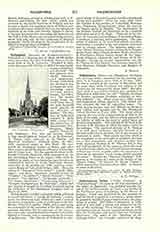

Valleyfield, Diocese of (CAMPIVALLENSIS)., Valleyfield is a thriving city of about 10,000 inhabitants, situated at the outlet of Lake St. Francis, on the south shore of the St. Lawrence. Founded in 1855, under the name of St. Cecilia, in 1874 it became legally known as Salaberry or Valleyfield. The first pioneers were chiefly fishermen and lumbermen. Today Valleyfield has developed into an important manufacturing center (cotton, paper, bronze, powder, etc.), the motive energy being derived from one of the most beautiful water powers of the Province of Quebec. The Diocese of Valleyfield (erected April 5, 1892) comprises the counties of Beauharnois, Chateauguay, Huntingdon, Vaudreuil, and Soulanges. The first and present bishop is Msgr. Joseph-Medard Emard (b. at St.-Constant, March 31, 1853, educated at St.-Therese and Montreal seminaries, ordained priest, June 10, 1876, appointed curate at Mile End). He completed his theological studies at Rome, and after three years received the degrees of Doctor of Theology and of Canon Law. He was appointed curate at St. Joseph‘s Church, Montreal, 1880, summoned by the late Archbishop Fabre to the palace, 1881, when he fulfilled the duties of vice-chancellor, gave lectures on ecclesiastical history at Laval University, became chancellor of the archdiocese, 1891, and was consecrated Bishop of Valleyfield, June 9, 1892. He is the author of: “Voyage en Terre Sainte”; several “Messages”: and many important pastoral letters on “l’Eglise”, “La justice”, “Devoir electoral”, “Temperance“, “Le serment”, “L’autorite paternelle”, “La femme chretienne”, “Communion frequente”, “Congres Eucharistique de Montreal”, which last was quoted at length by Cardinal Vanutelli during the festivities of the Eucharistic Congress held at Montreal, 1910.
Bishop Emard founded a classical college affiliated to Laval University, a “jardin de l’enfance”, a monastery for cloistered nuns (Clarisses), and a normal school for young ladies, took an active part in the first Plenary Council of Quebec (1909), and is supervising the restoration of the cathedral of the diocese, which contains admirable life-size portraits of the twenty-two popes who established and developed the Catholic Church in Canada, and is conspicuous for its beauty of architecture. The Diocese of Valleyfield is corn-posed chiefly of French Canadian families distributed among forty parishes. There are many Irish Catholic families in the parishes of Valleyfield, Huntingdon, Ormstown, Hemmingford, where the services are largely given in English. The descendants of the Iroquois Indians are ministered to by a resident missionary priest at St. Regis. There are in the diocese: 14 convents and academies, 2 classical colleges, 1 seminary, 4 asylums, and 3 orphanages. The education of children in the parochial schools and other institutions is confided to lay and religious professors and to secular priests. The religious orders are: men—Freres Viateurs; women—Soeurs de la Congregation Notre Dame; Soeurs de Jesus Marie; Soeurs de la Providence; Soeurs Grises; Soeurs de Ste Anne; Soeurs Clarisses (cloistered), and Soeurs de la Ste Famille. Among the secular organizations are: the St. Vincent de Paul Society; Les Artisans; Societe St. Jean Baptiste; Catholic Foresters; and Knights of Columbus.
J. DORAIS

